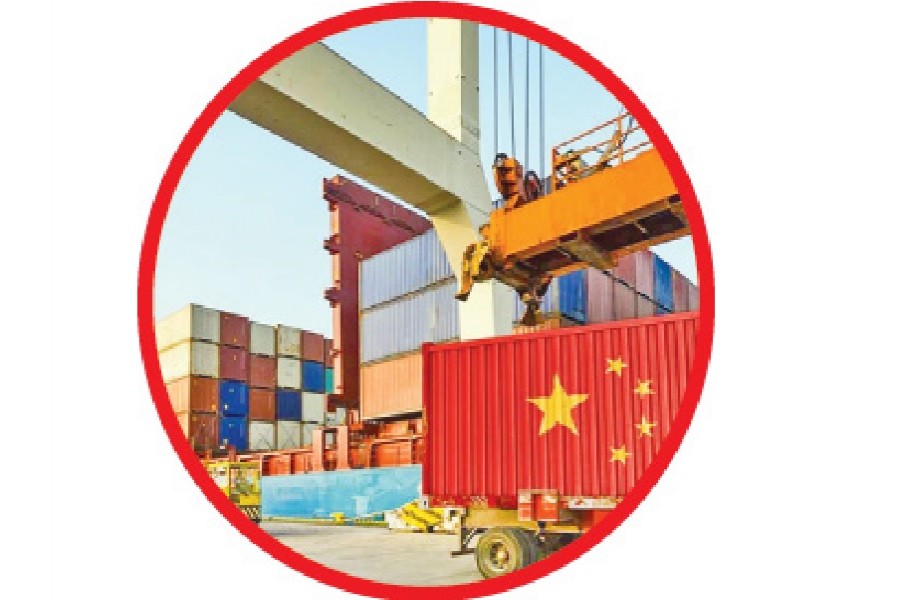The piece of news that China has allowed tariff-free market access to 97.0 per cent of Bangladeshi product comes at a time when the country is struggling to intensify its fight against the spread of coronavirus. Without delving deep into the mater, mass media in the country created hype as if Bangladesh has gained something very big and remarkable. Commerce ministry disseminated the piece of information in a manner as though it was the outcome of a prolonged trade negotiation. Some quarters linked the development with the Chinese move to support Bangladesh to fight against Covid-19. Some even go too far to try to explain it as a Chinese move to woo Bangladesh against the backdrop of the latest Indo-China border skirmish.
Indeed, China has finally granted duty-free market access to more Bangladeshi products and the result is that 8,256 products from Bangladesh will be eligible for the wide market access with effect from July 1, 2020. What is shrouded by the media hype is that Bangladesh has already been enjoying tariff-free market access to China for 60.0 per cent or 3095 products since 2015. China initiated the Duty-Free Quota-Free (DFQF) market access to LDCs in 2010 when 33 LDCs including Bangladesh became eligible for the benefit. The scheme was revised in 2015 and the number of beneficiaries stood at 40 LDCs. Zero tariff rates are applied for 97.0 per cent of products imported from 24 countries, 95.0 per cent of products from 14 countries, and 60.0 per cent of products from two countries -- Bangladesh and Mauritania.
Though availing the 97.0 per cent market access was open to Bangladesh, a condition imposed by China became a barrier to do so. China asked Bangladesh to adopt either Asia Pacific Trade Agreement (APTA) benefit or the LDC DFQF scheme and not both options simultaneously. Bangladesh disagreed to do so arguing that being a founder member of the trade bloc, it is not possible to do so.
Bangladesh has also been enjoying preferential market access in China through APTA by fulfilling 35.0 per cent value addition requirement. Under APTA, the benefit is not zero-duty, it is reduced duty.
Finally, China agreed to continue two types of market access schemes to Bangladesh. Thus 97.0 per cent of Bangladeshi products has become eligible for tariff-free market access benefit in China. To avail the benefit, any product needs to comply with either 40.0 per cent value addition criteria or change of tariff heading (CTH). CTH is defined as 'manufacturing or processing with materials partially or fully originating from non-beneficiary countries leading to a tariff heading change at the four-digit level of the final goods.'
The hype-makers seem to forget all these things. They also forget that market access requires adequate preparation. Moreover, it will depend on producers and exporters of Bangladesh as well as respective importers of China to utilise the benefit. Many LDCs are yet to utilise the benefit fully and are entering the Chinese market by paying Most Favoured Nation (MFN) duty to avoid complexity in complying with rules of origin.
As a matter of fact, according to the World Trade Organisation (WTO) estimation, China was the top destination for LDC merchandise exports in 2011. However, China was overtaken by the European Union (EU) in 2018 with a share of 28.50 per cent and China became the second destination with a share of 27.80 per cent of total LDC exports. The WTO report also showed that around 15.0 per cent of LDC exports entered China by paying MFN duties despite being eligible for preference or market access. The rate was around 5.0 per cent for Bangladesh in 2018 when around 90.0 per cent of the country's exports to China used 'LDC scheme or other preference' like APTA.
Some hype-makers argue that the generous market access will help Bangladesh reduce the bilateral trade deficit with China which is currently around $11.0 billion.
This kind of argument has no valid basis at all and it is almost impossible to reduce the trade gap with China. One-fourth of Bangladesh's total import is sourced from China and it will continue to increase in post-Covid period. The expectation that market access will enhance foreign direct investment (FDI) to tap duty-free access will also take time. Market access facility has little to do with attracting foreign investors in countries like Bangladesh. Overall investment and business climate is more important in this regard.
The reaction of leading trade bodies to the Chinese market access announcement is also not adequately backed by research. It appears from media reports that trade bodies are yet to be equipped with analytical information tools. Well-analysed feedback from the apex trade body is desirable.
Trying to link the market access announcement with Indo-China border skirmish is probably the most unwise thing to do. It is merely a coincidence that the announcement came at a time of Indo-China border tension.
One of the downsides of the Chinese market access benefit is that it will be short-lived as Bangladesh is set to leave the LDC league by 2024. The benefit will not be applicable for a non-LDC. Instead of focusing on the tariff-free market access, Bangladesh may put more attention on a free trade agreement with China which is also in the discussion for long.


